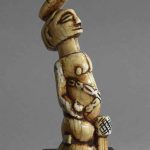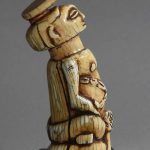Bakuba King, Hippotamus Ivory Figure, Congo
VKK 1112-5
This is a unique, classic representation of a Kuba king, also named Ndop carved in hippopotamus tusk.
Most probably Kuba King Kok Mabiintsh III in his ritual traditional regalia (1902 – 1916).
A ndop is made when a new king is invested with office; it is supposed to be an exact replication of the king and is a soul double. After the figure is carved, it is rubbed with camwood and palm oil to imply a reddish color. This was believed to ensure the fertility of the king and was kept near the wives, especially during childbirth. If the ndop became damaged at any point in time, it was to be replaced with an exact copy. At the death of the king, the ndop is brought to the new king’s initiation ceremony; it thereby passes over all of the prior king’s power to the new king. Once this ceremony ends, the figure is placed near the throne of the deceased king which is in a room near his grave (Cole, 384).
Age: Dates from the first half of the 20th century. Around 1920-1930.
The previous owner guarantees that this item is antique Hippo-tusk, crafted before 1947,
and thus, permitted under CITES regulations.
Measure: H: 16, W: 4, D: 6 cm – Weight: 310 grams
Condition: This object has a beautiful antique ivory patina and is in good condition with tiny normal age cracks.
The history of Kuba (also called Bakuba) people are agriculturalist and a cluster of Bushong-speaking ethnic groups of the larger Bantu ethnicity living in the Southeastern Democratic Republic of Congo between the Kasai and Sankuru rivers East of their confluence and are surrounded by other tribes such as the Suku, Yaka, and Pende (Cole, 381). Kuba who are well-known for their advance ritualistic sculptures and masks mostly made of hard wood.
When the kingdom of tribes was first brought together, the people were ruled by the Bushong people from the hill country of the central Congo (Caraway); these people have contributed most of the rulers to the Kuba. Whenever a king dies, the capital is moved to the location of the new King (Washburn, 19). Intertribal trading occurred often because the Kuba were such a powerful empire (Meurant, 121). Supernatural powers are the basis for the beliefs; spells, witchcraft, and channels between the living and the dead are some of these powers. The king is the chief of the sorcerer’s and bridges the boundary between the natural and the supernatural (Meurant, 122).
Kuba are part of the people that came to the Great Lake areas via the great Bantu migration from West Africa. The original Kuba migrated during the 16th century from the north to reach their current location at the Sankuru river. When they arrived, however, they found that the Twa already lived there. The Twa were eventually absorbed into the Kuba Kingdom but retained some independent cultural characteristics. The height of the Kingdom was during the mid-19th century.
Europeans first reached the area in 1884, but the Kuba, being relatively isolated, were not as affected by the slave trade as many of the other peoples in the area. The Nsapo invaded during the late 19th century, and the Kingdom was broken up to a large extent.
Fun fact
The difference between elephant and hippo tusk is that the hippo tooth remains white. That was the reason why US President Abraham Lincoln in his time got his denture made of Hippo tusk. Incidentally, this dental technique known back to the Pharaohs in Egypt. It is known that Abraham Lincoln suffered from bad dental hygiene and he eventually got an artificial denture.
Request price for Ivory Bakuba King



